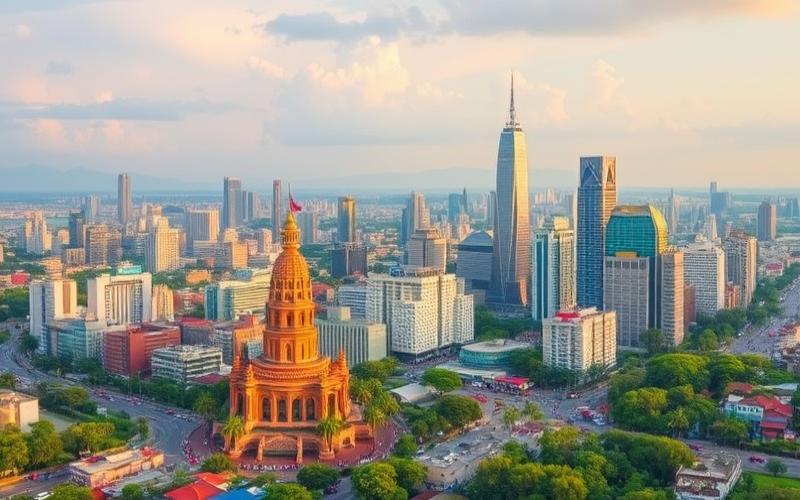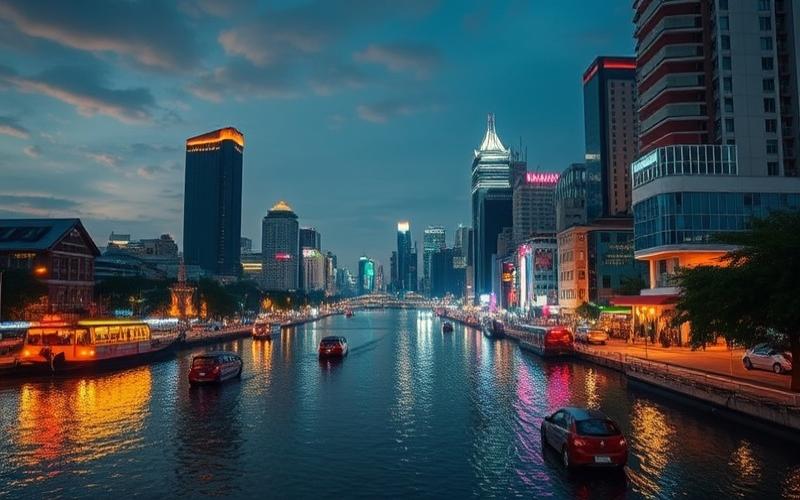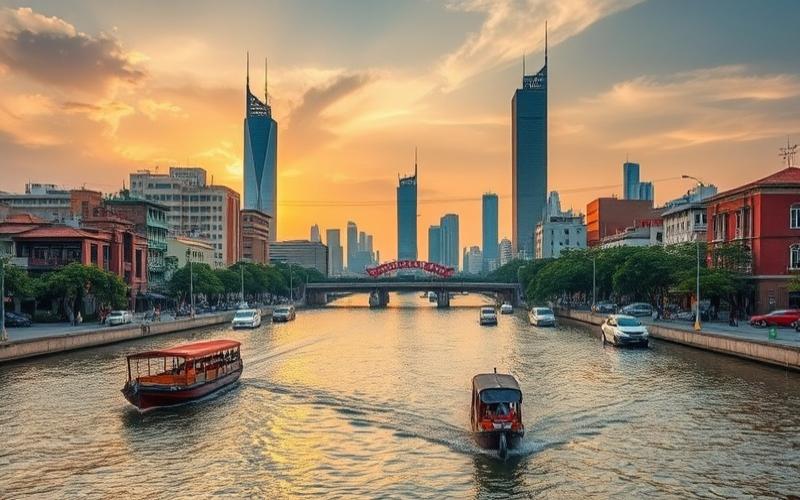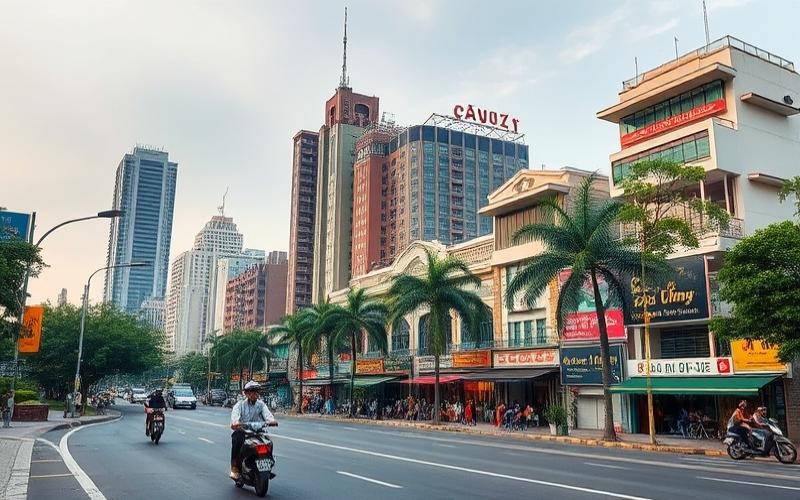
 Published on and written by Cyril Jarnias
Published on and written by Cyril Jarnias
Vietnam and the Transformation of Its Real Estate Market
Vietnam, experiencing rapid economic growth, is witnessing its real estate market transformed by innovations from abroad, with one of the most notable being the emergence of “dark stores” that are radically changing the urban and commercial landscape.
These neighborhood warehouses, dedicated exclusively to online orders, are proliferating at a dizzying pace, revealing unprecedented dynamics in urbanization and local commerce.
As Vietnamese consumers shift toward an increasingly digitalized lifestyle, these innovative infrastructures raise numerous questions about the long-term impact on the real estate sector and the reorganization of urban spaces.
Good to Know:
“Dark stores” are urban warehouses optimized for rapid deliveries, often invisible to consumers but strategically placed to meet the growing demand for e-commerce.
Dark Stores: A New Face of Real Estate in Vietnam
The emergence of dark stores in Vietnam fits within the context of rapid transformation in the real estate market, driven by the combined effects of commerce digitalization and accelerated urban growth. These logistics spaces, dedicated exclusively to preparing and delivering online orders, are developing particularly in major metropolises like Ho Chi Minh City and Hanoi, where urban density and demand for rapid delivery favor their establishment.
Economic and Technological Factors Explaining the Trend:
- Strong growth in e-commerce, stimulated by the rise of digital platforms and widespread smartphone adoption.
- Rapid urbanization and high population density in urban centers, making last-mile logistics crucial.
- Pressure on real estate costs encouraging optimization of used spaces.
- Technological innovations in inventory management, traceability, and logistics automation.
Comparison Between Dark Stores and Traditional Commercial Spaces:
| Criterion | Dark Stores | Traditional Commercial Spaces |
| Primary Use | Logistics warehouse, no on-site customers | Direct sales to the public |
| Preferred Location | Dense urban neighborhoods, logistics corridors | Shopping malls, commercial streets |
| Yield per Square Meter | Optimized for storage and preparation | Optimized for customer experience |
| Impact on the City | Reduction in visible neighborhood stores | Animation of the urban fabric |
Impact on Real Estate Prices and Urban Space Utilization:
- Targeted increase in rents for premises suited to urban logistics, especially in strategic neighborhoods close to consumer bases.
- Conversion of traditional commercial spaces (stores, small warehouses) into dark stores, altering the appearance of urban arteries.
- Increased tension in certain real estate segments, as these new uses compete with traditional residential and commercial needs.
- Transformation of urban space: some neighborhoods lose visible commercial appeal but gain in logistical efficiency.
Perspectives from Local Experts and Case Studies:
- According to Nguyên Quôc Anh, Deputy General Director of Batdongsan.com.vn, economic growth and rapid urbanization are major drivers of real estate transformation, with investors turning toward properties capable of adapting to new uses.
- Case studies in Ho Chi Minh City show that converting old stores into dark stores has allowed some owners to increase rental profitability but has sparked debates about the loss of neighborhood stores and the evolution of the urban landscape.
- Some urban planners warn of the risk of “dead storefronts” in city centers if the conversion of stores into dark stores is not regulated.
List of Main Observed Effects:
- Accelerated shift of urban centers toward a service and logistics logic.
- Strengthened speculation on well-located commercial spaces.
- Emergence of new trade-offs for property owners between yield, visibility, and space usage.
This phenomenon of dark stores illustrates the Vietnamese real estate market’s ability to adapt to technological changes, while also posing new challenges in terms of urban regulation and social cohesion.
Good to Know:
In Vietnam, dark stores are rapidly transforming the real estate landscape due to their role in online commerce, driving increased demand for spaces suited to storage and rapid order preparation. This trend is accelerated by technological innovations and economic changes, making traditional retail less competitive against these efficient, no-physical-sales-space structures. Consequently, urban real estate prices are experiencing fluctuations, particularly in industrial and peripheral areas, which are becoming preferred locations for these modern warehouses. According to local experts, this evolution offers real estate developers new opportunities to rethink the use of available spaces, while posing challenges for urban management and land regulation. A recent case study in Ho Chi Minh City illustrates how repurposing unused offices into dark stores helps revitalize previously declining neighborhoods, while increasing local competitiveness in the face of the e-commerce boom.
The Rise of Urban Warehouses for Rapid Logistics
The rise of urban warehouses in Vietnam is part of a dynamic of rapid growth in e-commerce and demand for express deliveries, especially in large urban areas like Ho Chi Minh City and Hanoi.
Urban warehouses play a key role in:
- Meeting the demand for rapid delivery in highly urbanized areas, where proximity to end customers is crucial.
- Supporting the growth of e-commerce, which imposes increasingly shorter delivery times and great logistical flexibility.
- Modernizing the supply chain through the integration of advanced technologies (automation, robotics, smart inventory management solutions).
Table: Impact of Urban Warehouses on the Vietnamese Ecosystem
| Aspect | Observed Effects |
| Warehouse Occupancy | High rate (up to 90% in Ho Chi Minh City) |
| Local Real Estate Market | Increase in land and rental prices |
| Surrounding Neighborhoods | Urban transformation, new jobs |
| Logistics Companies | Reduced delays, cost optimization |
| Retailers | Easier access to last-mile delivery |
| Foreign Investments | Increased attractiveness due to incentives |
Economic Benefits for Logistics Companies and Retailers:
- Decreased transit times and delivery costs.
- Better inventory management and reduced stockouts.
- Ability to offer same-day or 24-hour delivery services.
- Easier access to a large pool of urban consumers.
Influence on the Real Estate Market and Surrounding Neighborhoods:
- Increased value of land near roadways and dense residential areas.
- Pressure on urban land, potentially leading to rent increases and transformation of the urban fabric.
- Development of new logistics employment hubs, but also risks of local infrastructure saturation (traffic, nuisances, etc.).
List of Main Challenges Related to Urban Warehouse Implementation:
- Saturation of urban transport networks.
- Regulatory constraints: zoning, environmental standards, safety.
- Risks of usage conflicts with residents (noise, truck traffic, pollution).
- Need for massive investments in urban infrastructure (roads, energy, public services).
Evolution Perspectives:
- Continued sector growth: the compound annual growth rate of the warehousing sector is estimated at 11% until 2032.
- Rise of multimodal logistics hubs, integrating multiple transport modes to streamline distribution.
- Increased digitalization and automation to enhance operational efficiency and support growing e-commerce demand.
- Strengthening of public-private partnerships to accelerate investments in logistics infrastructure.
- Development of suburban areas: land pressure pushes for warehouse establishment in the periphery, transforming urban geography and favoring decentralization of activities.
The rise of urban warehouses in Vietnam is both a driver of logistical innovation and a catalyst for urban changes, but it also poses significant challenges in terms of urban integration, regulation, and long-term sustainability.
Good to Know:
In Vietnam, urban warehouses, also called “dark stores,” play a crucial role in meeting the growing demand for rapid deliveries in densely populated areas, thereby stimulating the real estate market by redefining urban space usage. These facilities, while beneficial for logistics companies and retailers through reduced transport costs and better inventory management, pose significant challenges in terms of urban infrastructure and local regulations. For example, occupying spaces once intended for traditional commercial activities can lead to tensions with residents and often requires adaptation of roads and public services. The evolution of this phenomenon is closely linked to the expansion of e-commerce in Vietnam, where a growing middle class shows an appetite for faster and more efficient services, suggesting a potential multiplication of such establishments in the future.
Investment in Logistics Real Estate for E-commerce
The spectacular rise in online sales in Vietnam is strongly stimulating demand for modern logistics spaces, a segment that has become central to supporting e-commerce expansion. The Vietnamese e-commerce market, already among the ten most dynamic in the world, reached a value of $20.5 billion USD in 2023 and is expected to reach $45 billion USD by 2025. In 2024, the GMV (Gross Merchandise Value) of the five main platforms (Shopee, Lazada, TikTok Shop, Tiki, and Sendo) amounted to $12.7 billion USD (+37% compared to 2023), with a projection of $15.4 billion USD for 2025.
List of Main Advantages of Logistics Real Estate for the E-commerce Sector:
- Accelerated delivery times thanks to urban proximity
- Optimized storage and efficient management of large flows
- Flexibility in adapting to seasonal peaks or massive promotions
- Reduced operational costs via automation and resource sharing
Key Regions Where the Logistics Industry is Strongly Developing:
| Region | Assets |
|---|---|
| Ho Chi Minh City | Major port hub; high commercial density |
| Hanoi | Rapid connection to the industrial north and delta |
| Binh Duong | Dynamic industrial park; access to infrastructure |
| Hai Phong | Strategic seaport |
The rapid emergence of dark stores – urban warehouses without customer service dedicated exclusively to ultra-fast preparation of online orders – is profoundly redefining the Vietnamese commercial real estate landscape. These structures enable:
- Optimal urban densification: establishment in centers or nearby peripheries to guarantee express delivery.
- Conversion of underutilized former commercial spaces.
- Increased flexibility in omnichannel management.
Major Opportunities for Real Estate Investors:
- Strong anticipated growth: stable forecasts of annual expansion exceeding +20% until 2026.
- Rapid appreciation of modern logistics assets equipped with automation or located near major urban centers.
- Growing development of cross-border e-commerce generating additional demand on international hubs.
Persistent Challenges:
- Land pressure in central areas sometimes limiting available supply;
- Need for heavy investments to meet international standards (automation/green logistics);
- Possible volatility linked to global and local economic fluctuations;
- Growing competition with the arrival of specialized regional players.
The main dynamic sectors in the Vietnamese market remain “Home & Garden” (17.96%), “Apparel” (17.60%), followed by “Beauty & Fitness,” “Food & Drink,” and “Business & Industrial.” This sectoral diversity further strengthens the structural resilience of the logistics real estate market against economic cycles.
Thus, logistics real estate dedicated to e-commerce represents an essential strategic lever in Vietnam—driven by robust growth but subject to a competitive environment demanding both in terms of land and technology.
Good to Know:
The explosion of online sales in Vietnam is driving strong demand for logistics spaces, with forecasts of logistics market growth reaching 6.7% per year until 2025. Investing in logistics real estate offers numerous advantages, including supply chain optimization and reduced delivery times for e-commerce players. Regions such as Ho Chi Minh City, Hanoi, and Da Nang are key development hubs for the logistics industry, attracting investors thanks to their expanding infrastructure. “Dark stores,” or ghost stores dedicated to managing online orders, are altering the commercial real estate landscape by making locations more strategic for urban distribution. However, investors must face challenges such as growing competition and the need to comply with local regulations, while benefiting from opportunities like implementing innovative technologies to gain efficiency.
Disclaimer: The information provided on this website is for informational purposes only and does not constitute financial, legal, or professional advice. We encourage you to consult qualified experts before making any investment, real estate, or expatriation decisions. Although we strive to maintain up-to-date and accurate information, we do not guarantee the completeness, accuracy, or timeliness of the proposed content. As investment and expatriation involve risks, we disclaim any liability for potential losses or damages arising from the use of this site. Your use of this site confirms your acceptance of these terms and your understanding of the associated risks.











































